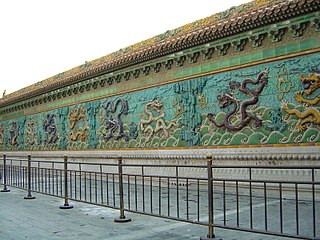The International Council on Monuments and Sites is a professional association that works for the conservation and protection of cultural heritage places around the world. Now headquartered in Charenton-le-Pont, France, ICOMOS was founded in 1965 in Warsaw as a result of the Venice Charter of 1964 and offers advice to UNESCO on World Heritage Sites.

Historic preservation (US), built heritage preservation or built heritage conservation (UK) is an endeavor that seeks to preserve, conserve and protect buildings, objects, landscapes or other artifacts of historical significance. It is a philosophical concept that became popular in the twentieth century, which maintains that cities as products of centuries' development should be obligated to protect their patrimonial legacy. The term refers specifically to the preservation of the built environment, and not to preservation of, for example, primeval forests or wilderness.

Conservation and restoration of immovable cultural property describes the process through which the material, historical, and design integrity of any immovable cultural property are prolonged through carefully planned interventions. The individual engaged in this pursuit is known as an architectural conservator-restorer. Decisions of when and how to engage in an intervention are critical to the ultimate conservation-restoration of cultural heritage. Ultimately, the decision is value based: a combination of artistic, contextual, and informational values is normally considered. In some cases, a decision to not intervene may be the most appropriate choice.
The Venice Charter for the Conservation and Restoration of Monuments and Sites is a set of guidelines, drawn up in 1964 by a group of conservation professionals in Venice, that provides an international framework for the conservation and restoration of historic buildings. However, the document is now seen as outdated, representing Modernist views opposed to reconstruction. Reconstruction is now cautiously accepted by UNESCO in exceptional circumstances if it seeks to reflect a pattern of use or cultural practice that sustains cultural value, and is based on complete documentation without reliance on conjecture. The change in attitude can be marked by the reconstruction in 2015 of the Sufi mausoleums at the Timbuktu World Heritage Site in Mali after their destruction in 2012.

The White City is a collection of over 4,000 buildings in Tel Aviv from the 1930s built in a unique form of the International Style, commonly known as Bauhaus, by German Jewish architects who fled to the British Mandate of Palestine from Germany after the rise to power of the Nazis. Tel Aviv has the largest number of buildings in the Bauhaus/International Style of any city in the world. Preservation, documentation, and exhibitions have brought attention to Tel Aviv's collection of 1930s architecture. In 2003, the United Nations Educational, Scientific and Cultural Organization (UNESCO) proclaimed Tel Aviv's White City a World Cultural Heritage site, as "an outstanding example of new town planning and architecture in the early 20th century." The citation recognized the unique adaptation of modern international architectural trends to the cultural, climatic, and local traditions of the city. Bauhaus Center Tel Aviv organizes regular architectural tours of the city.

Europa Nostra is a pan-European Federation for Cultural Heritage, representing citizens' organisations that work on safeguarding Europe's cultural and natural heritage. It is the voice of this movement to relevant international bodies, in particular the European Union, the Council of Europe and UNESCO. It has consultative status with UNESCO and is recognised as an NGO partner.
The Aga Khan Trust for Culture (AKTC) is an agency of the Aga Khan Development Network (AKDN), a family of institutions created by Aga Khan IV with distinct but complementary mandates to improve the welfare and prospects of people in the developing world, particularly in Asia and Africa. It focuses on the revitalization of communities in the Muslim world—physical, social, cultural, and economic. The AKTC was founded in 1988 and is registered in Geneva, Switzerland, as a private non-denominational philanthropic foundation.

Knoll is an American company that manufactures office systems, seating, storage systems, tables, desks, textiles, and accessories for the home, office, and higher education. The company is the licensed manufacturer of furniture designed by architects and designers such as Harry Bertoia, Ludwig Mies van der Rohe, Florence Knoll, Frank Gehry, Charles Gwathmey, Maya Lin, Marcel Breuer, Eero Saarinen, and Lella and Massimo Vignelli, under the company's KnollStudio division. Over 40 Knoll designs can be found in the permanent design collection of the Museum of Modern Art in New York City.

Global Heritage Fund is a non-profit organization that operates internationally. Founded in California in 2002, its mission is to "transform local communities by investing in global heritage."

The World Heritage Convention, formally the Convention Concerning the Protection of the World Cultural and Natural Heritage, is an international treaty signed on 23 November 1972, which created the World Heritage Sites, with the primary goals of nature conservation and the preservation of cultural properties. The convention, a signed document of international agreement, guides the work of the World Heritage Committee. It was developed over a seven-year period (1965–1972).
The estate Zonnestraal is a former sanatorium in Hilversum, the Netherlands. The building was designed by architects Jan Duiker Bernard Bijvoet and Jan Gerko Wiebenga, and is an example of the Nieuwe Bouwen. In 1995, the estate was submitted to UNESCO's list of World Heritage Sites, but it was ultimately not listed.
The World Monuments Watch is a flagship advocacy program of the New York-based private non-profit organization World Monuments Fund (WMF) that is dedicated to preserving the historic, artistic, and architectural heritage around the world.
The World Monuments Watch is a flagship advocacy program of the New York–based private non-profit organization World Monuments Fund (WMF) that is dedicated to preserving the historic, artistic, and architectural heritage around the world.
The World Monuments Watch is a flagship advocacy program of the New York–based private non-profit organization World Monuments Fund (WMF) and American Express to call upon every government in the world, preservation organizations, and other groups and individuals to nominate sites and monuments that are particularly endangered. At the same time, the nominators commit themselves to participate in a carefully planned preservation project.
The World Monuments Watch is a flagship advocacy program of the New York–based private non-profit organization World Monuments Fund (WMF) and American Express to call to action and challenge government authorities responsible for important cultural resources to identify sites immediately at risk, and to stimulate public awareness of the tremendous need to preserve and create sustainable uses for significant heritage made by man.

The Palace of Tranquil Longevity, literally, "peaceful old age palace", also called the Qianlong Garden, Qianlong Palace, Qianlong District or the Palace of Tranquility and Longevity, is a palace in Beijing, China, located in the northeast corner of the Inner Court of the Forbidden City.
The cultural monuments of the Czech Republic are protected properties designated by the Ministry of Culture of the Czech Republic. Cultural monuments that constitute the most important part of the Czech cultural heritage may be declared national cultural monuments by a regulation of the Government of the Czech Republic. Government may also proclaim a territory, whose character and environment is determined by a group of immovable cultural monuments or archaeological finds, as a whole, as a monument reservation. Ministry of Culture may proclaim a territory of a settlement with a smaller number of cultural monuments, historical environment or part of a landscape area that display significant cultural values as a monument zone.

The ADGB Trade Union School, is a training centre complex in Bernau bei Berlin, Germany. It was built for the former General German Trade Union Federation, from 1928 to 1930. It is a textbook example of Bauhaus functionalist architecture, both in the finished product and in the analytical and collaborative approach used to develop the design and complete the project. Next to the Bauhaus Dessau building, it was the second-largest project ever undertaken by the Bauhaus.
Hiroyuki Suzuki was a prominent Japanese architectural historian who also established a reputation abroad.
Save Venice Inc. is a U.S. non-profit organization dedicated to the conservation of art and architecture and the preservation of cultural heritage sites in Venice, Italy. Headquartered in New York City, it has an office in Venice, a chapter in Boston, and supporters across the United States and Europe.











